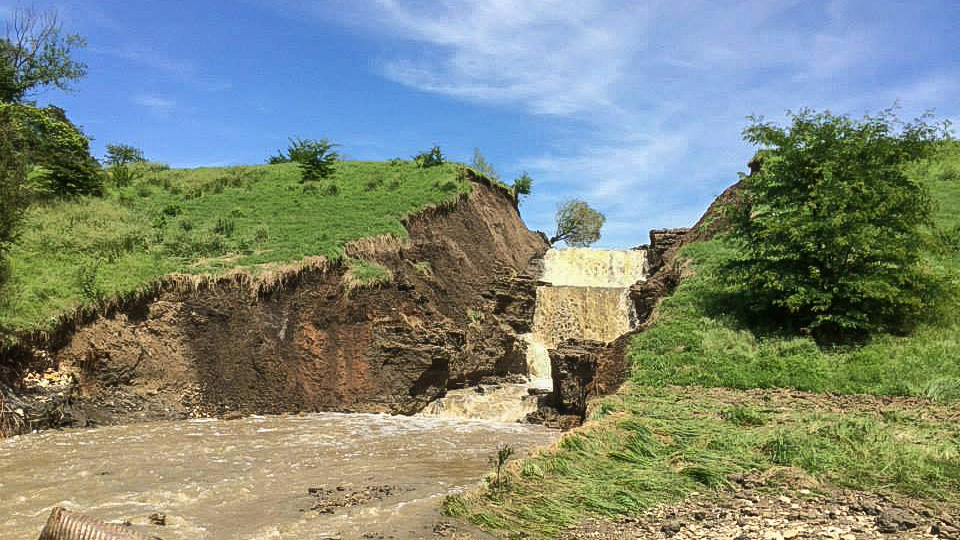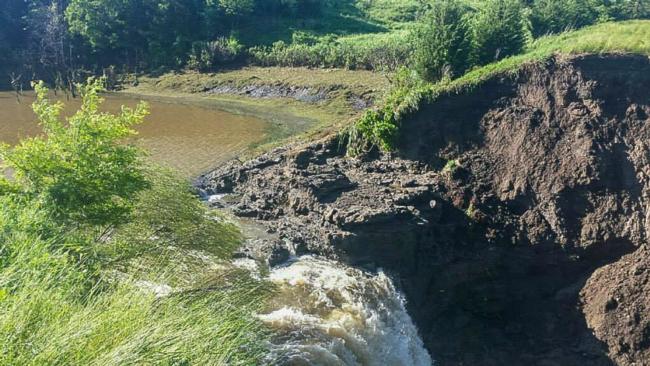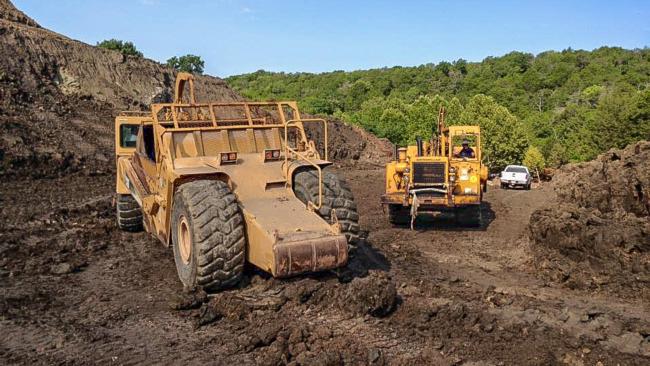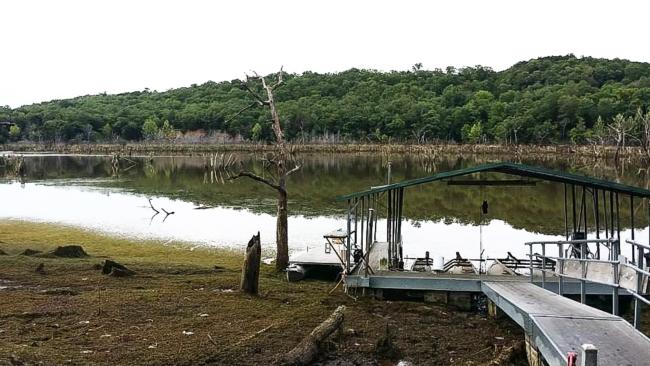Houston Rebuilding Lake After Dam Failure
Construction flaw the probable culprit that destroyed world-class Twin Eagle Lake

Twin Eagle Lake is dead.
But not for long.
One of pro bass fishing’s true legends has vowed to rebuild it. In the process, he plans to resurrect what might have been one of the best private trophy bass fisheries the state of Oklahoma has ever seen.
Twin Eagle is a 125-acre private lake located in the heart of Jimmy and Chris Houston’s Twin Eagles Ranch, just a stone’s throw from the couple’s rustic log home in the Arbuckle Mountains. Through the years the brush-filled honey hole has kicked out dozens of big bass upward of 8 pounds and several topping the 10-pound mark, including a lake record of a little more than 11 pounds. It has also been the site of many youth and veteran charity events, while providing a convenient setting for countless episodes of Houston’s popular television show, Jimmy Houston Outdoors.
“It was a great bass lake,” says Houston, a veteran on the Walmart FLW Tour. “It had some big ol’ crappie in it, too.”
Sadly, the only ones enjoying good fishing at Twin Eagle Lake these days are the blue herons. That’s because the lake was reduced to a virtual mud hole last May when heavy flooding across Oklahoma and Texas sent so much water flowing down Denmar Creek that it caused the lake’s dam to rupture, draining it in short order. Houston called it a catastrophe that sent an estimated 2 billion gallons of water and a staggering number of outsize bass and crappie on a cross-country path to the Washita River and, ultimately, Lake Texoma.
“We lost literally hundreds of thousands of dollars’ worth of fish. It was no doubt the biggest stocking of big bass and crappie that Texoma has ever had,” Houston jokes. “If I was fishing a tournament there right now I would definitely concentrate on the area where the Washita River dumps into the lake. There are some super-size bass finning around down there right now.”
Houston says the tragic loss was discovered on the evening of May 10, Mother’s Day, while he was in Eufaula, Ala., practicing for the May 14-17 FLW Tour event on Lake Eufaula. He was at a restaurant enjoying supper when his ranch manager called with the alarming news.
“The lake is full of brush, and he told me he could see trees and stuff sticking up out there that he’d never seen before,” Houston recalls. “He said something was bad wrong.”
Houston instructed the worker to check the dam and call him back.
“He was pretty upset when he called back,” Houston continues. “He said it [the dam] was gone. It started out as a 70-foot-wide hole that grew to about 250 feet wide by the time it was done. It looked like Niagara Falls when it happened.”
What Caused It
As noted, Oklahoma and Texas experienced an abnormally wet spring and early summer. Some areas across north Texas and southern Oklahoma received record rainfall that caused creeks and rivers to swell well beyond their banks and many lakes to fill well above full capacity. Lake Texoma, for instance, rose to more than 28 feet above full pool and topped the emergency spillway twice during June. As of Aug. 5, the lake still remained more than 11 feet above full pool.
Houston says his ranch received 30 inches of rain in May alone, which is just 4 inches shy of what falls there in an average year. Roughly 13 inches of rain fell just ahead of the Mother’s Day weekend.
Interestingly, however, the dam didn’t give way as the result of water rushing over the top. Instead, Houston says water ate away at the dam’s core and gradually worked its way out, likely because of the manner in which it was constructed in 1998 – about five years before he and Chris bought the property.
“It had a 24-inch metal pipe in it,” he says. “The pipe rusted out, and holes blew through on the inside. Once water started pushing through, it was done. The water was still about 2 feet from going over the emergency spillway when it broke through. It never should have happened, but it did.
“It was truly sickening,” Houston adds. “I remember walking out into the yard after we got home from the FLW tournament and looking across what was once one of the best, if not the best private lake in the entire county, and seeing nothing but mud and brush. It wasn’t like getting told you’re going to die in three weeks or anything like that, but it was a pretty bad deal. I cried like a baby.”
Moving Forward: The Decision to Rebuild
Twin Eagle Lake spans nearly 5 1/2 million square feet and is 54 feet deep at its deepest point when full. Rebuilding a dam capable of holding all that water is surely to be a costly and time-consuming venture with so many unknowns and variables that it would probably deter most 71-year-olds from attempting it.
Not Houston; in fact, construction crews began rolling onto his property in late July with trackhoes, bulldozers and other heavy equipment in tow.
“This is one of those things that you can’t just not fix,” Houston says. “We’re going to do it, and we’re going to do it right. There won’t be a pipe in this one. Instead, they are building a flow-over spillway made out of concrete.”
Houston says the contractor predicts he can have the dam completed by the end of August. In the meantime, other crews are working to build a new 90-foot-long fishing pier. The pier will be handicapped-accessible with rails along the side, which Houston says will be much more conducive to veterans and youth fishing events than the floating pier that has been in place since the lake was originally built.
Additionally, he plans to build a few rock piles and spawning areas.
“The lake already has tons of brush and other great structure in it, so there isn’t a whole lot to do as far as renovating the lake bed goes,” Houston explains. “The bottom is covered in waist-high grass right now that should be great for fertilization when the lake fills back up. We had a lot of coontail, lily pads and pondweed before the dam blew. We’re hopeful it will come back, and it should.”
Once the construction process is complete, Houston says the next order of business will be to hurry up and wait … for rain.
“That’s about all we will be able to do at that point,” he says. “The weather forecasters are saying we’re going to have a wet September, October and November this year, but that remains to be seen. Hopefully, they are right. There is only about 1/2 acre of water left out there right now, so we’ve got a ways to go before we can start thinking about restocking this thing.”
Stocking Up
Houston says the initial stockings will be geared heavily toward establishing a strong forage base using bluegills and threadfin shad. Game-fish stockings will be limited to crappies and adult F1 Florida-strain hybrid bass. He says the majority of the bass will be caught using rod and reel from a number of private lakes he has access to in Oklahoma, Texas and Arkansas. The fish will then be transported to his lake and released.
“One of the big keys to managing a private lake is removing a percentage of your smaller fish every year,” Houston says. “We’ll be able to restock this lake with a bunch of 3-pounders caught from other private lakes. Plus, we’ll probably buy some fish in the 1 1/2-pound range. Those fish will have been raised on [commercially available fish] food, but it won’t take them long to start thinking like a bass. They adapt pretty quick.”
The Future of Twin Eagle
Nobody knows for certain if or when Twin Eagle Lake will ever become the vibrant bass fishery it once was, but Houston says he feels optimistic about the prospects.
“I can tell you this – the Eagle will rise again,” he says. “Hopefully, if we get the water, in two years we’ll be back to good fishing, and in four to five years we’ll be back to great fishing. I probably won’t live long enough to get a tremendous amount of benefit out of it, but I might. There may come a day when I’ll be easing down to that fishing pier to catch me a big ol’ bass every now and then.”
Editor’s note: You can keep up with the rebuilding process at Jimmy Houston’s Twin Eagle Lake by following the Quaker State pro on his Jimmy Houston Outdoors Facebook page.


